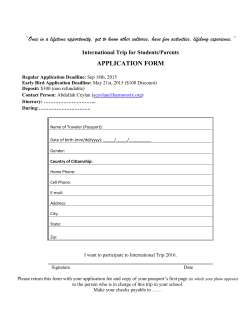
Rivertime - Lamont Books Home
Lamont Books 2014 Teacher Notes and Activities Rivertime By Trace Bella Publisher: Allen & Unwin ISBN 9781743316337 A tender and beautifully illustrated tale of a boy and his bird-watching uncle, on a paddling trip on Australia's Glenelg River. A story about slowing down, growing up, and connecting with the land and its creatures. 'All children need an Uncle Egg to open up the magical world of nature. We all need to get outside, away from television, computers and mobile phones, and what better way than a canoeing-camping trip? This is a delightful story about the joy of the outdoors.' David Suzuki. Teacher notes have been amended from those supplied by the publisher, Allen & Unwin. A full version is available from their website, www.allenandunwin.com. Themes: Friendship Aboriginal history Personal Growth River ecosystems Connecting with nature & country Discussion Points and Activities: Use quotes from the book to explore the themes above. Before reading use geographical tools, for example a globe, wall map or digital application such as Google Earth, to locate the Glenelg River in Victoria. Allow students to respond on a personal level to the story. Ask open-ended questions such as the following: What is your response to the book? What does it make you think and feel about Clancy’s journey on the river? What have you learnt? What do you think was the author’s intentions when making this book? Why was Clancy not very happy at the start of his trip? What did he miss about home? Talk about how reliant we all are on electronic devices for entertainment. Did this book make you think more about the natural world around us? How and why did his feelings change as the story went on? ‘We’re slowing down to rivertime…’ what do you think this means? Ask what the author needed to know to write and illustrate the story. Read the author’s note at the end of the book to help answer this question. She also reveals that a lot of the events in the story that happen to Clancy and Uncle Egg are based on real life experiences she had. This raises the issue of ‘fictionalised’ narratives. Talk about which elements might be factual and which fictionalised within the narrative. For example, names of the birds and animals are factual; Clancy trying to climb from the river is fictionalised. They could record this information on a T chart. [BLM 1 attached]. Students can refer to the T-charts to check and add extra information. Clancy learns a number of skills on the trip. Rope skills and knots can be learnt from animated diagrams easily available from an Internet search on ‘how to tie knots’. Provide students with two different colours of cord to practise knot tying. The class can create a display board of labelled knots for the school. Search Google Images on ‘knot board’: students can see many examples to help them decide on a design. Place you r m essag e h ere. Fo r m axim um i mpact , use two or t hre e se ntenc es.
© Copyright 2025









